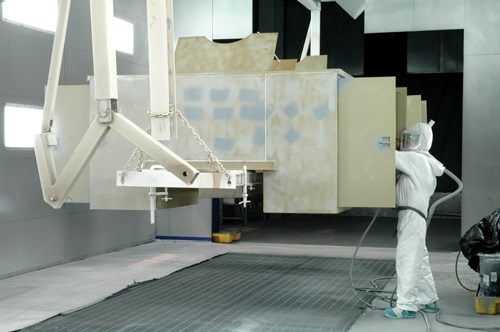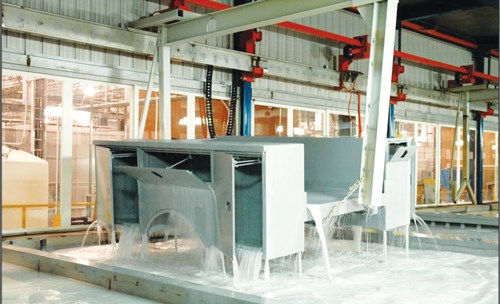Because it is an immersion process, electrocoating large truck bodies can present numerous difficulties, such as air entrapment, thorough draining, fluids carryout and bath contamination, striping, streaking, and low mil build.
But Altec Industries in Burnsville, N.C., a manufacturer of heavy truck bodies and related equipment, partnered with
Therma-Tron-X, Inc. to add e-coat to its finishing operation and—through the proper design and execution of an electrocoat/liquid spray topcoat paint system —addressed those issues.
Altec’s products are used by the electric utility, telecommunications, tree care and sign/outdoor lighting maintenance industries. It has 25 manufacturing, final-assembly and service facilities across North America and Canada, including the facility in Burnsville, which opened in 2006 to produce truck bodies.
The company’s previous process used a combination cleaner/phosphate pretreatment followed by a rinse, both using a spray wand system. Two coatings were applied by liquid spray: an epoxy primer and urethane topcoat. The nature of the products required that application of each pretreatment step and paint coat be thorough in coverage and density to provide adequate corrosion and UV protection.
Automated process
Since it is an immersion process, e-coat reaches all surfaces of the product, both inside and out. Electrocoating is self-limiting, meaning that the film thickness can be closely controlled through the applied voltage because the paint insulates the part as it is deposited. Coupled with a transfer efficiency of 95 percent or more, paint waste is minimized.
Altec selected a square transfer electrocoating system for two reasons. First, the large product size required relatively long drain times, and a conveyor system with a high-load limit was necessary. Secondly, a square transfer system can outperform a programmed hoist in terms of throughput.
Although the initial workload was expected to be low, the square transfer system offered significantly higher capacity for future sales increase. This was in addition to the standard advantages of smaller tanks, smaller footprint, lower chemical and paint tank fill costs, and lower utilities and water usage.
The pretreatment regimen in the Altec electrocoating system consists of a nine-stage pretreatment (zinc phosphating) process:
The third stage is equipped to become a heated acid pickle bath. Because Altec uses galvanized steel in the construction of its products, the pickle is not required.
The electrocoating process contains three steps:
- The cream-color, cationic-epoxy electrocoating bath is maintained at 90°F. Only two post-rinses are necessary due to extended process cycle duration and a greater-than-usual counterflow rate, which helps to maintain a lower percentage of paint solids in the second and third rinse tanks. The post-rinse consists of recycled permeate counterflowed from the second rinse, which is fresh permeate from the ultrafilters plus reverse osmosis (RO) makeup water.
- After a body has completed the pretreatment and electrocoating process, the truck body and auxiliary parts are exposed to a 30-minute dehydration and bake time in the overhead cure oven before entering a cool-down zone.
- They continue to cool as they exit the square transfer system and are transferred to a power and free conveyor for transit through the topcoating line.
Process Concerns
Air entrapment can be an issue in the immersion treatment of any complex enclosure. The utility bodies manufactured by Altec have many interior surfaces and, despite propping all compartment doors open during processing, air release was expected to be difficult. Extensive testing was carried out to determine the optimal orientation for product hanging. In addition, the utility boxes were re-engineered to add small release points to the design that did not compromise product performance.
For the same reasons as air entrapment, thorough drainage of process fluids during tank transfers is critical. Dragout and bath contamination is problematic in many immersion finishing operations; processing of complex enclosures can make the effect much more dramatic. In addition to re-engineering, drain time was extended between stages, from 40 seconds initially to 99 seconds.
Some design features are known to cause coating problems. For instance, unsealed joints where steel is lapped may enable liquids to seep in. Excessive solution retention in these tight areas on a “first-in, last-out” basis means that cleaner that gets trapped in the initial stage may not be fully released during draining and could still be concealed in the lapped joint when curing begins—at which point it boils out and mars the finish.
The best way to address this difficulty is to remove overlapping metal joints from the design altogether. The solution in this case was an initial hot-water rinse applied prior to the cleaner solution with an extended oven dehydration zone to slowly evaporate trapped fluids prior to curing.
Striping is a condition often found with live entry monorail immersion tanks, where a lined effect occurs in the finish as the parts are immersed into the paint solution. This problem is eliminated on the Altec system using the Therma-Tron-X Slide Rail Square Transfer (SST) system because the voltage is not activated until the parts are completely immersed in the electrocoating solution.
Streaking is a phenomenon caused by excessive drying of the parts removed from the tanks with too much elapsed time for draining. This can be overcome by assuring the design properly drains excessive material and proper exhaust balancing of the system enclosure, especially in the tank area.
Problems with low film build may occur due to the size of the largest truck bodies. Areas nearest the tank anodes (the exterior) will easily reach the desired film thickness, while deep recesses may not be coated at all due to the limitations of throw power.
Use of the SST system enables Altec to closely control film build through the use of automatic voltage control (AVC). When a load enters the tank, the programmable logic controller (PLC) determines its square footage from the amperage draw. Rectifier voltage is then applied in four increasing steps based on the load size: 100, 165, 230 and 270 volts. Truck bodies will undergo exposure to all four steps, while auxiliary parts having lower square footage may only experience the first or second voltage levels. In this way, smaller loads are not overexposed, which can result in coating rupture.
During system startup and the subsequent adjustment period, Altec erred on the side of too much voltage, resulting in film builds of up to 1.5 mils. This has now been dialed back to a thickness between 0.8 and 1.2 mils—more than sufficient for a corrosion-resistant electrocoat primer.
Overcure is a concern. Due to the Altec production process, the system operator releases loads into the system manually. This can result in irregular cycle times, although rarely longer than the 4.45-min automated cycle. However, the cream-colored electrocoat paint is formulated with double overbake capabilities. Even though overexposure in the oven can result in a darker drab/greenish brown color on the product, adhesion properties are maintained, and because this is a primer coat, coloration is not a concern.
Load capacity also is monitored. The square transfer system hydraulics were originally sized to process one full-size truck body. As production increases, a second hydraulic unit will be added to handle two bodies in every three loads. In case of maintenance or repair, the system will still be able to continue electrocoating at the old one-in-three rate using only one operational hydraulic unit.
After the truck bodies are electrocoated, they are automatically transferred and transported by a 4 × 4-inch power and free conveyor from the load/unload area of the SST system to a series of booths and ovens involved in the topcoating process. The topcoat process is as follows:
- Sanding booth
- Cool Down Area/Tack
- Caulking Station (sealing seams)
- Second Topcoat Booth
- First Topcoat Booth
- Cooldown/Masking Area
- Topcoat Bake Oven
- Undercoating Booth
The first stop is the sanding booth, where visible surfaces of the truck bodies are touched up prior to topcoating to achieve a Class A finish. Gross residue is blown off before proceeding to the caulk booth. Roll-up doors segregate all topcoat process steps from adjoining booths to minimize heat loss, reduce dirt and dust transfer, and maintain comfortable working conditions.
Caulk is applied to the bodies to seal all external seams to assure a watertight construction prior to application of topcoat. A urethane adhesive caulk used in the aerospace industry is applied via air-actuated caulk guns. The caulk is allowed to cure before the product indexes to the next step where it is wiped down manually to remove any remaining dirt that might have accumulated from the previous operations.
The topcoat booth is fitted with downdraft filtration. A paint kitchen automatically mixes and delivers white and orange paint, which is applied to 98 percent of Altec’s product line. Custom colors are sprayed from 5-gal pots. The majority of the truck bodies are sprayed with an undercoating layer later in the process.
The topcoat oven was constructed against the exterior of the building and runs at 180°F. Throughout the topcoating area, load bars disconnect from the power and free conveyor at predefined stations to ensure line workers have sufficient time to complete their tasks. When a body has completed topcoating, the paint operator releases the body for the next position. The PLC tracks the position of bodies throughout the paint system, including the paint booth, and automatically indexes the next body into the booth when a paint position becomes available.
The second topcoat booth is used for application of topcoat as well as clear coat. The gray interiors of tool-chest drawers and toolboxes are also coated here. Parts then proceed to the touch-up oven, set at 190°F. After exiting the cure oven, the parts receive a final inspection and are checked for dry film thickness to assure compliance to specification. This enables the bodies to cool before being masked for undercoating. The undercoating step is now not as essential for rustproofing due to the excellent corrosion protection afforded by the electrocoat primer, meaning that less undercoating material is required to shield the finished product. In fact, some key customers request painted underbodies in lieu of undercoating because of the excellent corrosion performance.
Parts are transferred by forklift to the final dress-out line where the bodies are finished out. A final touchup booth located after the dress-out operations is used for added inspection and to repair any spots damaged in the dress-out process.
Employing an electrocoat primer enabled Altec Industries to achieve a more corrosion-resistant finish on its utility truck body products. Choosing a SST system gave Altec a superior prime coat in a fraction of the space necessary for a monorail, due to smaller process tanks. The SST concept is also better able to handle the weight of large, complex parts with interior cavities as they are immersed and withdrawn from each stage, and can out produce a programmed hoist of similar weight capacity.
Process concerns regarding air entrapment and solution drainage were solved through re-engineering release points in the product enclosures. The electrocoat primer as applied by the SST system gives Altec’s products better pretreatment and helps streamline the topcoating process. n
For more information on Therma-Tron-X Inc., call 920-743-6568 or visit therma-tron-x.com.




















